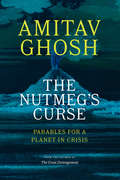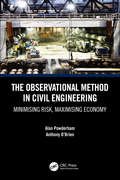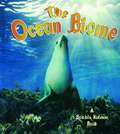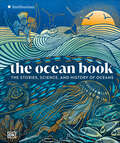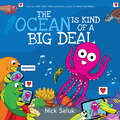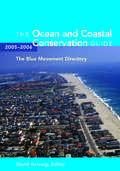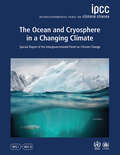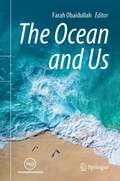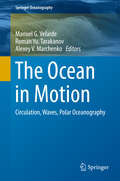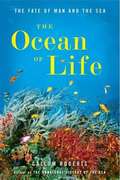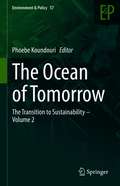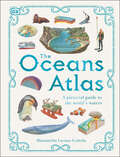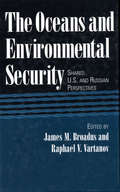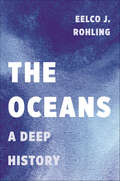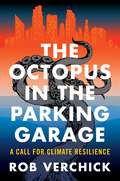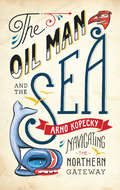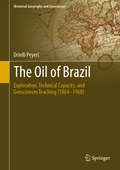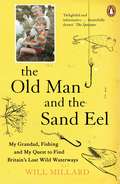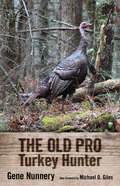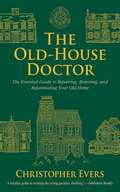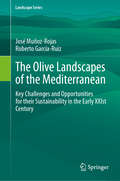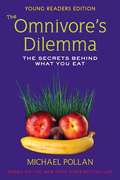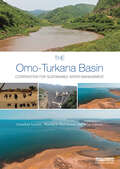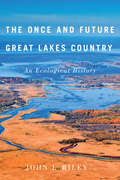- Table View
- List View
The Nutmeg's Curse: Parables for a Planet in Crisis
by Amitav GhoshThe author of The Great Derangement finds the origins of our climate crisis in Western colonialism&’s violent exploitation of human life and the environment. A powerful work of history, essay, testimony, and polemic, Amitav Ghosh&’s new book traces our contemporary planetary crisis back to the discovery of the New World and the sea route to the Indian Ocean. The Nutmeg&’s Curse argues that the dynamics of climate change today are rooted in a centuries-old geopolitical order constructed by Western colonialism. At the center of Ghosh&’s narrative is the now-ubiquitous spice nutmeg. The history of the nutmeg is one of conquest and exploitation—of both human life and the natural environment. In Ghosh&’s hands, the story of the nutmeg becomes a parable for our environmental crisis, revealing the ways human history has always been entangled with earthly materials such as spices, tea, sugarcane, opium, and fossil fuels. Our crisis, he shows, is ultimately the result of a mechanistic view of the earth, where nature exists only as a resource for humans to use for our own ends, rather than a force of its own, full of agency and meaning. Writing against the backdrop of the global pandemic and the Black Lives Matter protests, Ghosh frames these historical stories in a way that connects our shared colonial histories with the deep inequality we see around us today. By interweaving discussions on everything from the global history of the oil trade to the migrant crisis and the animist spirituality of Indigenous communities around the world, The Nutmeg&’s Curse offers a sharp critique of Western society and speaks to the profoundly remarkable ways in which human history is shaped by non-human forces.
The Observational Method in Civil Engineering: Minimising Risk, Maximising Economy
by Anthony O'Brien Alan PowderhamThe Observational Method (OM) is a natural and powerful technique that maximises economy while assuring safety. Its key features are highlighted in The Observational Method in Civil Engineering through eleven case histories from major infrastructure projects. They cover protection of adjacent structures including buildings and railway systems, bored and jacked tunnels, shafts and cofferdams, retaining walls, embankments, deep foundations, ground improvement and groundwater control. They illustrate how the OM can achieve more effective collaboration between the client and the design and construction teams, as well as how it can enhance the industry’s ability to learn from experience, thus improving future practice and stimulating innovation. Despite these advantages, the OM is significantly underused. The book demonstrates how the full potential of the OM can overcome a wide range of concerns and constraints. Other chapters address the advantages and limitations of the OM, the key role of progressive modification, the art of achieving agreement and the commercial and contractual environment. The book will appeal to a range of construction professionals, including civil, structural and geotechnical engineers, contractors and owners. It will also be of interest to students and researchers.
The Ocean Alphabet Book (Jerry Pallotta's Alphabet Books)
by Jerry PallottaLearn your ABCs in this aquatic exploration of everything under the sea. Best-selling author Jerry Pallotta delivers a fun first concepts book that covers sea creatures from A to Z. From speckled cod to jellyfish to the shiny shells of scallops, readers will be introduced to over twenty-six species that live in the North Atlantic Ocean. Jerry Pallotta&’s signature witty while scientifically accurate text paired with fun and detailed illustrations by Frank Mazzola Jr. make this a fun read aloud that kids and parents will be eager to dive into.
The Ocean Biome (The Living Ocean Series)
by Kathryn SmithymanThe four zones of the marine bio me,their plants and animals, coral reefs and estuaries, the importance of oceans to the Earth, and how they are in danger.
The Ocean Book: The Stories, Science, and History of Oceans (DK Nature Books)
by DKImmerse yourself in this beautiful, absorbing guide to the marine world. Earth owes its identity as the blue planet to the vast oceans of water that cover almost 70 percent of its surface. Home to an abundance of marine life and vital in regulating Earth's climate, the oceans are also the scene of daring exploits of exploration, intense rivalries between trading empires, and global warfare. Combining arresting photography; rich illustrations; and engaging, expertly written text, The Ocean Book showcases the landscapes; plants and animals; and captivating human stories of the world's oceans. Whether you're interested in blue whales, the El Nino climate oscillation, the search for the Northwest Passage, the sinking of Titanic, or pirates, this is the perfect exploration of the ocean realm.
The Ocean Is Kind of a Big Deal
by Nick SelukOh hey, guess what? New York Times bestseller Nick Seluk has a hilarious new nonfiction picture book all about the world's biggest ecosystem -- the ocean!Have you ever thought about everything the ocean does for you? It changes the weather, creates oxygen, provides food, and is a great place to have fun, too! So why is the ocean such a big deal? Because we couldn't live without it!This funny and factual picture book from Heart and Brain creator Nick Seluk explains the science behind the ocean: its plant and animal life, its contribution to the world, and what we can do every day to protect it. Humans wouldn't be able to survive without a healthy ocean. That's kind of a big deal.Each spread features bite-sized text and comic-style art with sidebars sprinkled throughout. Anthropomorphized marine animals help readers learn through funny jokes and comic panels. Funny, smart, and accessible, The Ocean Is Kind of a Big Deal is a must-have!
The Ocean and Coastal Conservation Guide 2005-2006: The Blue Movement Directory
by David HelvargA new environmental movement is emerging to help combat threats to America's oceans and coasts, with hundreds of local and regional groups as well as dozens of national and international organizations being formed. The Ocean and Coastal Conservation Guide represents a comprehensive guide to this new "Blue Movement." This one-of-a-kind new reference details more than 2,000 organizations and institutions that are working to understand, protect, and restore our ocean and coastal areas. For each entry, the book gives contact information including phone and fax numbers, email addresses, web addresses and a brief description of program areas of interest. Along with the state-by-state listings of groups, the directory includes three detailed sections that identify relevant government agencies, academic marine programs, and marine and coastal parks and protected areas. To be published biennially, The Ocean and Coastal Conservation Guide is a vital new resource for anyone interested in the growing community of people working to protect and restore our coastal lands and waters.
The Ocean and Cryosphere in a Changing Climate: Special Report of the Intergovernmental Panel on Climate Change
by Intergovernmental Panel on Climate Change (IPCC)The Intergovernmental Panel on Climate Change (IPCC) is the leading international body for assessing the science related to climate change. It provides policymakers with regular assessments of the scientific basis of human-induced climate change, its impacts and future risks, and options for adaptation and mitigation. This IPCC Special Report on the Ocean and Cryosphere in a Changing Climate is the most comprehensive and up-to-date assessment of the observed and projected changes to the ocean and cryosphere and their associated impacts and risks, with a focus on resilience, risk management response options, and adaptation measures, considering both their potential and limitations. It brings together knowledge on physical and biogeochemical changes, the interplay with ecosystem changes, and the implications for human communities. It serves policymakers, decision makers, stakeholders, and all interested parties with unbiased, up-to-date, policy-relevant information. This title is also available as Open Access on Cambridge Core.
The Ocean and Us
by Farah ObaidullahThe Ocean and Us provides an overview of our contemporary understanding of the ocean and all the ways our lives interact with it. It is intended for everyone with an interest in our blue planet. The book brings together the expertise of over 35 ocean specialists from around the world. It explores a wide variety of themes including the importance of a healthy ocean in the fight to halt and contain climate change. It covers issues such as overfishing and pollution, as well as emerging themes such as the blue economy, marine animal welfare and how we can leverage innovation to protect the ocean. The book provides an overview of some of the world’s iconic threatened and at risk ocean ecosystems, and outlines current governance structures and ocean management tools. It also discusses the important social dimensions between people and the ocean, such as ocean and human wellbeing, communities and the ocean, and who gets to participate in the ocean space. The book aims to enhance ocean literacy by making specialist concepts accessible to non-experts, with a view to empowering concerned citizens everywhere to come into action for the ocean, and pave a better way forward for humanity.
The Ocean in Motion: Circulation, Waves, Polar Oceanography (Springer Oceanography Ser.)
by Manuel G. Velarde Roman Yu. Tarakanov Alexey V. MarchenkoThis book commemorates the 70th birthday of Eugene Morozov, the noted Russian observational oceanographer. It contains many contributions reflecting his fields of interest, including but not limited to tidal internal waves, ocean circulation, deep ocean currents, and Arctic oceanography.Special attention is paid to studies on internal waves and especially those on tidal internal waves in the Global Ocean. These papers describe the most important open problems concerning experimental studies of internal waves and their theoretical, numerical, and laboratory modeling.Further contributions investigate the physics of surface waves and their interaction with internal waves. Here, the focus is on describing interaction processes between internal waves and deep currents in the ocean, especially currents of Antarctic Bottom Water in abyssal fractures. They also touch on the problem of oceanic circulation and related processes in fjords, including those occurring under sea ice. Given its breadth of coverage, the book will appeal to anyone interested in a survey of ocean dynamics, ranging from historic perspectives to modern research topics.
The Ocean of Life: The Fate of Man and The Sea
by Callum RobertsA Silent Spring for oceans, written by "the Rachel Carson of the fish world" (The New York Times) Who can forget the sense of wonder with which they discovered the creatures of the deep? In this vibrant hymn to the sea, Callum Roberts—one of the world’s foremost conservation biologists—leads readers on a fascinating tour of mankind’s relationship to the sea, from the earliest traces of water on earth to the oceans as we know them today. In the process, Roberts looks at how the taming of the oceans has shaped human civilization and affected marine life. We have always been fish eaters, from the dawn of civilization, but in the last twenty years we have transformed the oceans beyond recognition. Putting our exploitation of the seas into historical context, Roberts offers a devastating account of the impact of modern fishing techniques, pollution, and climate change, and reveals what it would take to steer the right course while there is still time. Like Four Fish and The Omnivore’s Dilemma, The Ocean of Life takes a long view to tell a story in which each one of us has a role to play. .
The Ocean of Tomorrow: The Transition to Sustainability – Volume 2 (Environment & Policy #57)
by Phoebe KoundouriAs a response to the climate crisis and its effect on marine ecosystems and coastal populations, this book proposes concrete science driven solutions at establishing transformation pathways towards Sustainable Blue Growth, that are supported by technically and socially innovative innovations. This book proposes investment options and management solutions that have the potential of making our seas and oceans resilient to crises- climate, financial, health- by laying the foundations for a green/blue, circular economy that is anchored in science driven solutions and geared toward public well-being. Now is the time to usher in systemic economic change and the good news is that we have our blueprint: it’s the combination of UN Agenda 2030 (17 SDG) and European Commission’s European Green Deal! There is no doubt that the Earth’s survival will depend on the protection and sustainable management of our seas and oceans and the resources they provide. This is recognized by the Joint Communication on International Ocean Governance, which is an integral part of the EU’s response to the United Nations’ 2030 Agenda for Sustainable Development, and in particular to the targets set out by Sustainable Development Goal 14 (SDG 14) to “conserve and sustainably use the oceans, seas and marine resources”. The analytical framework and science-driven concrete management solutions proposed in this book can accelerate the transition to a sustainable management of our seas and oceans, by turning the current challenges into opportunities for sustainable economic growth which is both environmentally resilient and leaves no one behind.
The Oceans Atlas (DK Pictorial Atlases)
by DKDelve beneath the world&’s oceans to discover their physical features, wildlife, and threats to their future.How do waves form? Where is the deepest part of the ocean? What is a black smoker? What would the ocean floor look like without water? What lives in a coral reef? If you find yourself seeking the answers to these questions, then this may be the book for you!Introducing The Oceans Atlas – a beautifully illustrated guide to Earth&’s oceans for kids aged 9-12. Explore key features of the oceans from seafloor to surf, including tides and trenches, currents and coastline, volcanoes and vents. Discover the variety of marine life from the biggest sharks and whales to the tiniest invertebrates and polyps. Find out the human impact on our seas and how we can create a healthier and cleaner future.Dive straight into this ocean book for kids, offering: - An illustrated guide to the innermost depths of our oceans that shows details not visible in photographs.- A variety of maps from seafloor topography and cross-sections to shipping routes and ocean resources. - Original and retro-feel illustration style combined with modern fonts which creates a different approach compared to photographic or CGI-based books.From coral reefs to hazardous seas, The Oceans Atlas is an engaging, fact-packed guide for children aged 9–12, especially those interested in natural science, geography, or ecology. So whether you&’re a budding young geographer, or a teacher looking for an engaging resource to use in your classroom, this oceans encyclopedia is full of fascinating facts to impress young readers time and time again. At DK, we believe in the power of discovery. So why stop there? If you like The Oceans Atlas, then why not complete the collection? Take a peek inside the beautiful and absorbing world of birds with The Bird Atlas, explore the complex animal kingdom with The Animal Atlas, reveal the inner workings of the human body with The Body Atlas and take a trip around the globe with The Earth Atlas.
The Oceans and Environmental Security: Shared U.S. And Russian Perspectives
by Raphael V. Vartanov Suzanne M. Demisch Artemy A. Saguirian Tom Tietenburg James Broadus Matthew J. LamourieThe concept of environmental security, drawing on the widely understood notion of international strategic interdependence (in facing, for example, threats of nuclear war or economic collapse) is gaining currency as a way of thinking about international environmental management.In 1989, the Institute for World Economy and International Relations of the Russian Academy of Sciences and the Marine Policy Center of Woods Hole Oceanographic Institution instituted a joint project to examine environmental security as it applies to the world's oceans. The Oceans and Environmental Security is a unified expression of their findings.The oceans, as global commons, are of central importance to issues of international environmental security. Critical problems are those that are likely to destabilize normal relations between nations and provoke international countermeasures. As such, the book focuses on seven specific concerns: land-based marine pollution North Pacific fisheries depletion hazardous materials transport nuclear contamination the Arctic Ocean the Southern Ocean and Antarctica the Law of the Sea
The Oceans: A Deep History
by Eelco J. RohlingThe 4.4-billion-year history of the oceans and their role in Earth's climate systemIt has often been said that we know more about the moon than we do about our own oceans. In fact, we know a great deal more about the oceans than many people realize. Scientists know that our actions today are shaping the oceans and climate of tomorrow—and that if we continue to act recklessly, the consequences will be dire. In this timely and accessible book, Eelco Rohling traces the 4.4 billion-year history of Earth’s oceans while also shedding light on the critical role they play in our planet’s climate system.Beginning with the formation of primeval Earth and the earliest appearance of oceans, Rohling takes readers on a journey through prehistory to the present age, vividly describing the major events in the ocean’s evolution—from snowball and greenhouse Earth to the end-Permian mass extinction, the breakup of the Pangaea supercontinent, and the changing climate of today. Along the way, he explores the close interrelationships of the oceans, climate, solid Earth processes, and life, using the context of Earth and ocean history to provide perspective on humankind’s impacts on the health and habitability of our planet—and on what the future may hold for us.An invaluable introduction to the cutting-edge science of paleoceanography, The Oceans enables you to make your own informed opinions about the environmental challenges we face as a result of humanity’s unrelenting drive to exploit the world ocean and its vital resources.
The Octopus in the Parking Garage: A Call for Climate Resilience
by Rob VerchickOne morning in Miami Beach, an unexpected guest showed up in a luxury condominium complex’s parking garage: an octopus. The image quickly went viral. But the octopus—and the combination of infrastructure quirks and climate impacts that left it stranded—is more than a funny meme. It’s a potent symbol of the disruptions that a changing climate has already brought to our doorsteps and the ways we will have to adjust.Rob Verchick examines how we can manage the risks that we can no longer avoid, laying out our options as we face climate breakdown. Although reducing carbon dioxide emissions is essential, we need to adapt to address the damage we have already caused. Verchick explores what resilience looks like on the ground, from early humans on the savannas to today’s shop owners and city planners. He takes the reader on a journey into the field: paddling through Louisiana’s bayous, hiking in one of the last refuges of Joshua trees in the Mojave Desert, and diving off Key Largo with citizen scientists working to restore coral reefs. The book emphasizes disadvantaged communities, which bear the brunt of environmental risk, arguing that building climate resilience is a necessary step toward justice.Engaging and accessible for nonexpert concerned citizens, The Octopus in the Parking Garage empowers readers to face the climate crisis and shows what we can do to adapt and thrive.
The Oil Man and the Sea: Navigating the Northern Gateway
by Arno KopeckyA sailing trip along the proposed Northern Gateway marine route with a fresh new voice in non-fiction.With oil and gas behemoth Enbridge Inc.'s Northern Gateway proposal nearing approval, supertankers loaded with two million barrels of oil may soon be plying the waters from northern British Columbia down the wild Pacific Coast. <P><P>This region is home to the largest tract of temperate rainforest on earth, First Nations who have lived there for millennia, and some of the world's most biodiverse waters-one spill is all it will take to erase ten thousand years of evolution.Arno Kopecky and his companions travel aboard a forty-one-foot sailboat exploring the pristine route-a profoundly volatile marine environment that registered 1,275 marine vessel incidents-mechanical failures, collisions, explosions, groundings, and sinkings-between 1999 and 2009 alone. Neither Kopecky nor the boat's owner have ever sailed before, yet they brave these waters alone when their captain leaves them part way through the journey.Written with Kopecky's quick humor and deft touch, this is a rich evocation of a mythic place and the ecology, culture, and history of a legendary region with a knife at its throat.
The Oil of Brazil: Exploration, Technical Capacity, and Geosciences Teaching (1864-1968) (Historical Geography and Geosciences)
by Drielli PeyerlThis book investigates the role of the National Petroleum Council (CNP) and especially of Petrobras in the construction and shaping of courses in Geosciences, as part of the historical process of the search for and exploration of oil, which began in Brazil in 1864 and ended in 1968 with the discovery of the first offshore well.The book explores the history of the discovery of oil in Brazil together with the historical development of oil research and geosciences in Brazil. It also elucidates significant events and developments which occurred between 1864 and 1968 such as the foundation of the Ouro Preto Mining School, the foundation of the CNP and Petrobras and other scientific societies and universities and their contributions to the formation and constitution of geosciences in Brazil. This book also discusses the massive investments by CNP and Petrobras in technical and scientific research for oil exploration in the Brazilian territory.This unique book appeals to scientists, students and professionals in geosciences, history and related fields.
The Old Man and the Sand Eel
by Will Millard'A wonderfully fluent account of how the strange magic of water and the beings that inhabit it can enchant and intoxicate' Chris YatesGrowing up on the Cambridgeshire Fens, Will Millard never felt more at home than when he was out with his granddad on the riverbank, whiling away the day catching fish. As he grew older his competitive urge to catch more and bigger fish led him away from that natural connection between him, his grandfather and the rivers of his home. That is, until the fateful day he let a record-breaking sand eel slip through his fingers and he knew that he had lost the magic of those days down by the river, and that something had to change. The Old Man and the Sand Eel is at its heart the story of three generations of men trying to figure out what it is to be a man, a father and a fisherman. It plots Will's scaly stepping stones back to his childhood innocence, when anything was possible and the wild was everywhere.***'[Will Millard] is a master wordsmith and his first book is a joyful testament to that' Isabelle Broom, Heat'[Will Millard] writes with a genuine sense of humility (...) humour and reflection' Kevin Parr, Countryfile 'Delightful and informative (...) beautifully drawn (...)The Old Man and The Sand Eel will be enjoyed by anyone who loves the challenge and mystery of baiting a hook and plopping it into the water' Spectator'This is post-modern nature writing that embraces beauty where it finds it and marvels at nature's tenacity (...) But there's more here than just fish. This is also a book about growing up, about how to retain a connection with those who raised you while forging your own identity - what to keep and what to discard. And it's about men. The strong surges of emotion that both draw them together and keep them apart, and the shared pastimes which recognise that intimacy and meaning aren't always accompanied by words' Olivia Edward, Geographical
The Old Pro Turkey Hunter
by Gene NunneryDuring his life, Gene Nunnery was recognized as a master turkey hunter and an artisan who crafted unique, almost irresistible turkey calls. In The Old Pro Turkey Hunter, the vaunted sportsman shares over fifty years of personal experience in Mississippi and surrounding states, along with the decades-old wisdom of the huntsmen who taught him. Throughout the book, his stories make clear that turkey hunting is more than just killing the bird—it is about matching wits with a wild and savvy adversary. As Nunnery explains, “To me that’s what it’s all about: finding a wise old gobbler who will test your skill as a turkey hunter.” Through his stories, Nunnery reveals that the true reward for successful turkey hunting lies in winning the contest, not necessarily exterminating the foe. Real sportsmen know that every now and then the turkey should and will elude the hunter. As Nunnery looks back on his extensive career, he analyzes vast differences in practice, old and new. The shift, he decides, came during his last twenty years on the hunt, and that difference has only increased in the decades since this book was originally published. Michael O. Giles, Bass Pro staff team member, master turkey hunter, and award-winning outdoors writer and author of Passion of the Wild, writes a new foreword that brings the practice of turkey hunting into the present day. Filled with a tested mixture of common sense and specific examples of how master turkey hunters honor their harvest and heritage, The Old Pro Turkey Hunter is the perfect companion for the novice or the adept.
The Old-House Doctor: The Essential Guide to Repairing, Restoring, and Rejuvenating Your Old Home
by Christopher EversOld houses are charming, but owning one can be a labor of love. Expert carpenter and house "doctor" Christopher Evers equates old homes with ailing patients, describing how you can successfully "treat" your old house and make it good as new. With over 300 clear, line illustrations, Evers provides a practical guide to repairing, renovating, and preserving your old house--basement to attic--so you can enjoy it for years to come. Evers gives detailed instructions on the "anatomy" of old homes as well as how to fix a variety of problems, including:Repairing old plumbing fixturesReplacing shingles on the roofStraightening the house’s frameRewiring old electrical systemsRemoving old wallpaperProtecting against termites and other harmful pestsAdding insulation for better energy efficiencyFixing old eavesReinstalling windows and doorsAnd more!A classic in old-home repair, The Old-House Doctor is an invaluable, and timeless, guide for keeping your old home in tip-top shape, while meeting your modern needs.
The Olive Landscapes of the Mediterranean: Key Challenges and Opportunities for their Sustainability in the Early XXIst Century (Landscape Series #36)
by José Muñoz-Rojas Roberto García-RuizThis book provides a state-of-the-art review of the current models and typologies of olive landscapes and related farming systems in the Mediterranean. It also explores potential prospects for monitoring and enhancing their sustainability standards. Olive groves are an essential component of the historical landscape that largely drive the cultural, ecological and socio-economic character of the region. Agronomic intensification and mechanization, market globalization and delocalization, and financialization are affecting these ancient farming systems in certain olive landscapes, whereas others are threatened by abandonment and financial loss. This complex set of processes is resulting in a heterogeneous mosaic of olive landscapes when examined across nested spatial-temporal scales and institutional levels. In alignment with such complexity, multiple challenges are arising linked to sustainability standards and targets. Sustainability has actually been the subject of much public discussion and yet of not nearly enough scientific evidence-gathering that is both robust and comparable across geographic contexts and scales. This is where this book is expected to provide a meaningful contribution. Ultimately, the main objective of this book is to establish a base-line sustainability picture of the complex mosaic of olive landscapes across the Mediterranean region. The book is structured along a series of national /regional and thematic reviews and syntheses, which lead to joined-up reflections on current and future challenges, opportunities and trajectories for enhancing the sustainability of olive landscapes across the Mediterranean. The book will be of interest to academics and researchers, policy-makers, the farming community, and market agents alike. We expect that they will find in this book an overall picture of the sector´s current situation and plausible pathways for achieving enhanced sustainability standards, whilst also permitting the reader to gain depth on the contingent characteristics of the different drivers, components and typologies of these dynamic and valuable landscapes.
The Omnivore's Dilemma: The Secrets Behind What You Eat (Young Readers Edition)
by Michael PollanThe New York Times bestseller that's changing America's diet is now perfect for younger readers. "What's for dinner?" seemed like a simple question--until journalist and supermarket detective Michael Pollan delved behind the scenes. From fast food and big organic to small farms and old-fashioned hunting and gathering, this young readers' adaptation of Pollan's famous food-chain exploration encourages kids to consider the personal and global health implications of their food choices. In a smart, compelling format with updated facts, plenty of photos, graphs, and visuals, as well as a new afterword and backmatter, The Omnivore's Dilemma serves up a bold message to the generation that needs it most: It's time to take charge of our national eating habits--and it starts with you.
The Omo-Turkana Basin: Cooperation for Sustainable Water Management (Earthscan Series on Major River Basins of the World)
by Jonathan LautzeThis book provides a comprehensive examination of water resource management in the Omo-Turkana Basin, linking together biophysical, socioeconomic, policy, institutional and governance issues in a solutions-oriented manner. The Omo-Turkana Basin is one of the most important lake basins in Africa, and despite the likely transboundary impacts associated with the management of dams, it is the largest lake basin in Africa without a cooperative water agreement. This volume provides a foundation for integrated decision-making in the management of development in the Lake Turkana Basin. Chapters cover water-related conditions, hydropower, agriculture, ecosystems, resilience and transboundary governance. The final chapter proposes ways forward in light of the potential benefits that can be achieved through cooperation, and practical realities that cooperation is slow and may take time to achieve. This book will be of great interest to students and scholars of water and natural resource management, environmental policy, sustainable development and African studies. It will also be relevant to water management professionals.
The Once and Future Great Lakes Country: An Ecological History (McGill-Queen's Rural, Wildland, and Resource Studies #2)
by John L. RileyNorth America's Great Lakes country has experienced centuries of upheaval. Its landscapes are utterly changed from what they were five hundred years ago. The region's superabundant fish and wildlife and its magnificent forests and prairies astonished European newcomers who called it an earthly paradise but then ushered in an era of disease, warfare, resource depletion, and land development that transformed it forever. The Once and Future Great Lakes Country is a history of environmental change in the Great Lakes region, looking as far back as the last ice age, and also reflecting on modern trajectories of change, many of them positive. John Riley chronicles how the region serves as a continental crossroads, one that experienced massive declines in its wildlife and native plants in the centuries after European contact, and has begun to see increased nature protection and re-wilding in recent decades. Yet climate change, globalization, invasive species, and urban sprawl are today exerting new pressures on the region’s ecology. Covering a vast geography encompassing two Canadian provinces and nine American states, The Once and Future Great Lakes Country provides both a detailed ecological history and a broad panorama of this vast region. It blends the voices of early visitors with the hopes of citizens now.
